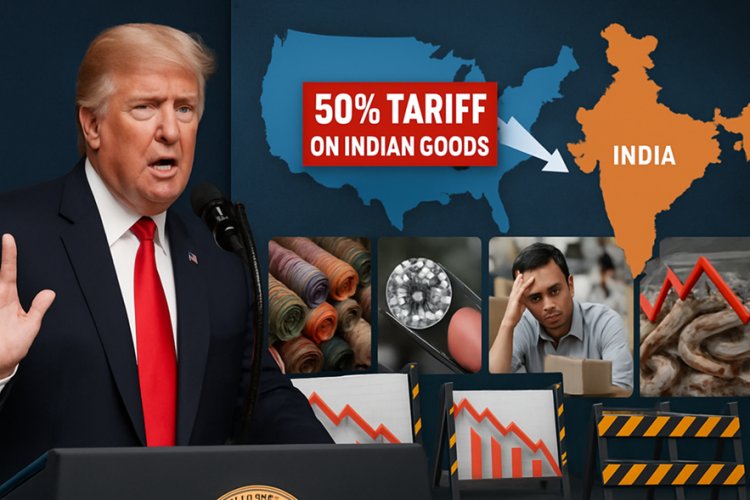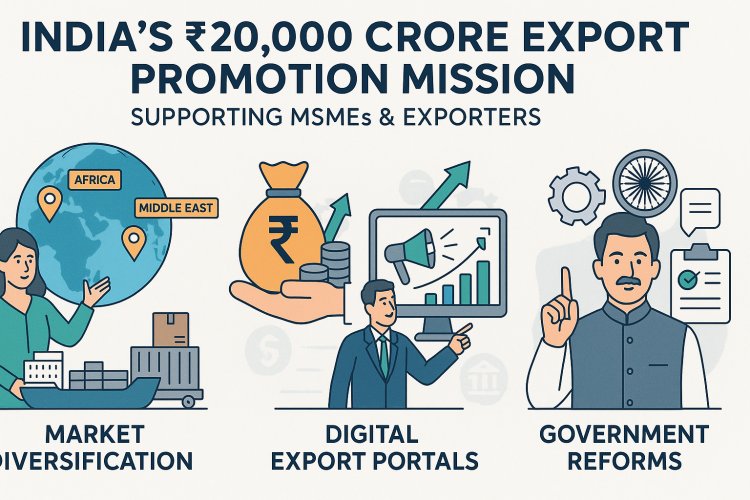Trump Slaps 50% Tariffs on India: The High-Stakes Trade War and India's Bold Countermoves India's ₹20,000 Crore Fightback
Trump imposes 50% tariffs on India, triggering a high-stakes trade war. Discover India's ₹20,000 crore countermeasures and what this clash means for global trade.

In August 2025, US President Donald Trump announced an additional 25% tariff on Indian imports—raising total tariffs up to 50%—as a penalty for India’s continued oil trade with Russia. This decision, effective August 28th, marks the highest tariff the US has imposed on any nation and has been widely labeled in India as “unjustified” and “unfair.” The move has sent shockwaves through India’s export-oriented sectors and triggered a comprehensive government response, including the launch of a major Export Promotion Mission.
Timeline of Trump Tarriffs Developments

Sectors Hit the Hardest From Trump Tarriffs:
-
Textiles & Apparel
-
Jewelry & Gems
-
Leather and Footwear
-
Seafood & Agricultural Products
-
Auto Components & Engineering Goods
-
Consumer Goods (non-electronics)
Pharmaceuticals and electronics currently remain exempt, but future escalations are possible.
Trump Tarriffs Economic and Industry Impact (Short-term)
-
Exports in Crisis: US is India’s largest export destination, accounting for 18% of total exports (~$86.5B), contributing roughly 2% to India’s GDP. 50% tariffs are expected to render many Indian products uncompetitive, risking up to 60% drop in shipments to the US.
-
GDP at Risk: Forecasters expect the impact could shave as much as 1% off India’s GDP growth—undermining forecasts of 6.5% for FY26 and threatening employment, especially in labor-heavy sectors.
-
Stock Market Jitters: Indian equity markets have seen heightened volatility, especially for companies with heavy US export exposure in automobiles, textiles, and ancillary sectors.
-
MSMEs Vulnerable: Small exporters and MSMEs, heavily reliant on US orders, face acute stress and potential closures.
India's Multi-Pronged Response On trump Tarriffs:
1. ₹20,000 Crore Export Promotion Mission
-
Targeted Relief: Support to affected exporters, especially MSMEs, with enhanced access to credit and cross-border factoring.
-
Market Diversification: Intensive campaign ("Brand India") to find new overseas markets, focusing on ASEAN, Africa, and Middle East.
-
Regulatory & Digital Push: Simplified documentation, digital trade portals, streamlining customs, and infrastructure upgrades to reduce transaction costs.
-
Quality and Innovation: Capacity building to help meet international quality norms and facilitate product upgrades; funding for compliance and sustainability.
-
WTO Compliance: Avoidance of direct subsidies (to stay within WTO trade rules), focusing instead on capacity building and sectoral incentives through compliant schemes.
2. Trade Diplomacy
-
Continued Talks: Despite public rhetoric, backdoor negotiations continue, with India seeking tariff relief in exchange for opening up certain markets to US goods (e.g., more dairy and industrial imports).
-
No Compromise on Farmers: PM Modi has stated India will not sacrifice the interests of its farmers, dairy and fishing sectors—major sticking points in the ongoing talks with the US.
3. Strategic Realignment
-
Geopolitical Signaling: India is sending a message that it will not bow to unilateral US pressure, even as it explores global alliances and alternate supply chains to reduce reliance on the US market.
Long-term Implications Due to Trump Tarriffs:
Negative Scenarios
-
Export Slowdown: Persistent high tariffs could lead to a permanent reduction in India’s US market share, with Vietnam, Mexico, and Bangladesh poised to gain.
-
GDP Slippage: An annualized GDP hit of 0.6–1.1% is projected if tariffs stay and exemptions narrow.
-
Labor Market Shock: Job losses in textile, leather, and jewelry clusters, with knock-on effects in rural and semi-urban economies.
Opportunities and Silver Linings
-
Self-Reliance & Diversification: Forced innovation and search for new markets could ultimately strengthen India’s resilience.
-
Modernization Boost: Digital trade portals, logistics upgrades, and higher quality standards could raise India’s global competitiveness.
-
Strategic Assertiveness: India is learning to leverage its market size in bilateral deals—expect a harder stance in future negotiations with both Western and Eastern partners.
Case Study Insights By Product For Indians:
-
MSME Exporter’s Struggle: Small apparel exporter from Tiruppur, Tamil Nadu reported nearly all US orders canceled within a week of the 50% tariff news, as American buyers turned to Mexico and Vietnam. The exporter is now looking at the Middle East and EU, but cites high compliance and marketing costs.
-
Government’s Relief Scheme: Under the new Export Promotion Mission, this exporter receives expedited credit lines and help with international certifications, allowing a pivot to new buyers in the UAE and South Africa, but with margins 10–20% lower than in the US market.
-
Textile Clusters: Surat (jewelry) and Ludhiana (garments) face severe demand shocks, yet local associations have begun joint trade fair campaigns under the “Brand India” initiative, with some early wins in ASEAN.
Analyst & Industry Opinions On Trump Tarrif
-
Leading industrialists and industry bodies have characterized Trump’s escalation as the “law of unintended consequences,” arguing the move gives India an impetus similar to the 1991 reforms—an opportunity to enact bold new trade liberalization and reform, despite the short-term pain.
-
The consensus among economists is that while the shock is severe, India’s long-term fundamentals remain strong, provided the government executes its export support and market diversification plans effectively.

How will India’s ₹20,000 Cr export mission counteract Trump’s tariff impacts in the long term
India’s ₹20,000 crore Export Promotion Mission is structured to deliver both immediate relief and long-term transformation for the nation’s export sector as it faces the impact of Trump’s escalated tariffs. Here’s how it will help counteract the adverse effects over the long run:
1. Market Diversification
-
The mission aggressively pursues new export markets beyond the US—such as ASEAN, Africa, and the Middle East—helping Indian exporters reduce dependence on any single country and mitigate tariff-related risks.
2. Support for MSMEs
-
Targeted financial assistance and credit facilities will help small and medium exporters survive the initial shock and adapt to new market realities. Special schemes are being implemented to help them acquire international certifications, upgrade technology, and compete in global markets.
3. Capacity Building and Quality Upgrades
-
Significant funds are earmarked for quality improvements, digitalization, and R&D to raise product standards. This will help Indian products meet stringent international requirements, making them more competitive worldwide (not just in the US).
4. Regulatory Simplification
-
The mission includes a push for single-window clearance, streamlined export documentation, and upgraded trade infrastructure. Smoother logistics and simplified processes reduce costs and delivery times, directly improving exporters’ global competitiveness.
5. Digital Trade and Branding
-
Investment in digital trade portals and “Brand India” campaigns will help Indian exporters reach new international buyers efficiently and with lower marketing costs.
Expected Long-term Effects
-
Resilience & Reduced Vulnerability: By building new markets and supporting self-reliance, India’s export sector becomes less exposed to future tariff shocks from any one nation.
-
Boosted Innovation: The emphasis on higher quality standards and product innovation will likely move Indian exports up the value chain, transitioning from low-margin commodities to premium goods.
-
Higher Global Share: With diversified destinations and superior logistics, Indian exports could capture a larger share in fast-growing emerging markets, offsetting US losses over time.
-
Policy Momentum: The crisis may act as a ‘1991 moment’—serving as a catalyst for broader reforms in trade, labor, and infrastructure that offer lasting structural advantages.
In summary, India’s ₹20,000 crore Export Promotion Mission is designed not just as a crisis-management tool, but as a foundational strategy to future-proof the export sector, enhance competitiveness, and drive sustainable growth even in a volatile global trade environment.

How might India strategically renegotiate trade deals to reduce dependency on US markets
India can strategically renegotiate trade deals and reduce its dependency on US markets through a combination of diplomatic initiatives, market diversification, and structural reforms. Here’s a detailed strategy drawing upon the context of current trade tensions and recent government efforts:
1. Expanding and Deepening Regional & Bilateral Trade Agreements
-
Strengthen Ties with ASEAN, Middle East, Africa & Latin America: India can actively negotiate or upgrade Free Trade Agreements (FTAs) and Comprehensive Economic Partnership Agreements (CEPAs) with regions like ASEAN, the Gulf Cooperation Council (GCC), African Union, and MERCOSUR. These regions have growing consumer bases and increasing demand for Indian goods ranging from pharmaceuticals to engineering and agri-products.
-
Prioritize EU-India FTA: The stagnant EU-India FTA negotiations could be fast-tracked to access the world's largest single market, opening major opportunities in textiles, engineering, and IT.
2. Recalibrating Existing Trade Partnerships
-
Revise Terms in Existing FTAs: India can renegotiate FTAs with countries like Japan, South Korea, and Australia to achieve better market access for its competitive sectors and safeguard sensitive industries through tariff quotas or review mechanisms.
-
Leverage Quad & Indo-Pacific Alliances: Use strategic partnerships in the Indo-Pacific (Quad: US, Japan, Australia, India) to foster technology, supply chain, and trade cooperation with non-US members.
3. Targeted Diplomacy with Emerging Markets
-
African Focus: Strengthen 'India-Africa Forum Summit' outcomes by negotiating trade facilitation, concessional lines of credit, and standards harmonization agreements, especially for pharmaceuticals, light engineering, and food processing.
-
Latin America Connections: Deepen preferential trade ties, especially in agro-products and automotive components, with countries like Brazil, Chile, and Mexico.
4. Building Strategic Value Chains
-
South-South Supply Chains: Collaborate with Vietnam, Bangladesh, and Indonesia to form alternative value chains (like textiles, electronics, and auto components) that can help India integrate with global supply networks, making its exports more resilient to single-country shocks.
5. WTO-Based Multilateral Approach
-
Leadership at WTO: India can champion developing-country causes at the WTO, working with the G-20 and G-33 blocs to push for easier market access for its priority sectors (agriculture, MSMEs, IT) and resist protectionism.
6. Sector-Specific Initiatives
-
Tie In Domestic Reform With External Strategy: Use the momentum of reforms (PLI schemes, logistics improvements, export credit) to project ‘Brand India’ and negotiate from a position of strength.
-
Mutual Recognition Agreements (MRAs): Secure MRAs on standards and certifications with non-US jurisdictions, facilitating easier access for Indian products.
7. Invest in Trade Facilitation & Promotional Networks
-
Trade Missions & Bilateral Forums: Organize more business-to-business and government-to-government trade missions in priority geographies, supporting Indian exporters in meeting local demands and cultural expectations.
-
Digital Trade Platforms: Invest in country-specific digital export promotion (e.g., language support, compliance resources) to help Indian MSMEs access new buyers globally.
Long-Term Perspective On Trump Tarrifs
If implemented cohesively, this strategy will:
-
Reduce direct commercial risks from US policy swings or tariff wars.
-
Accelerate India’s entry and growth in newer, less contested global markets.
-
Upgrade Indian product quality and supply chain flexibility, raising global competitiveness.
-
Position India as a hub not just for exports, but also for value-added processing and innovation in the Global South.
In summary: India's game plan should be proactive: expand ties with new markets, recalibrate FTAs, deepen value chains with emerging economies, and back it all with trade facilitation and domestic reforms. This will turn the current challenge into an opportunity for long-term, broad-based export growth.
Which Indian sectors are most vulnerable to tariffs and how can they adapt quickly
The Indian sectors most vulnerable to US tariffs, especially in light of the recent escalation up to 50%, are those heavily reliant on the US market—often with thin margins and limited market diversity. Here’s a breakdown of the key sectors and practical strategies for rapid adaptation:
Most Vulnerable Indian Sectors to US Tariffs
1. Textiles & Apparel
-
The US is India's largest market for garments and home textiles.
-
Labor-intensive, with many MSMEs, thin profit margins.
-
Major clusters: Tiruppur, Ludhiana, Surat.
2. Gems & Jewelry
-
The US buys almost a quarter of Indian jewelry exports, especially cut and polished diamonds.
-
High value, but also high competition from countries like Thailand and Israel.
3. Leather & Footwear
-
USA is one of the top buyers of Indian leather goods, shoes, and accessories.
-
Employs millions, particularly in regions like Kanpur, Agra, and Tamil Nadu.
4. Auto Components
-
Many Indian auto part makers are tightly integrated into the US supply chain (after-market, OEM).
-
Disruption could mean loss of long-term relationships.
5. Seafood & Agricultural Products
-
Shrimp and other marine products face high sensitivity to tariffs.
-
Products like spices, rice, and processed foods could also be hit.
6. Some Consumer Goods
-
Non-electronic consumer items like furniture, kitchenware, and handicrafts face competitiveness issues with higher tariffs.
How These Sectors Can Adapt Quickly From Trump tarrifs
1. Market Diversification
-
Explore New Markets: Shift focus towards growing markets in the Middle East, ASEAN, Africa, and Latin America.
-
Leverage Trade Agreements: Make better use of existing FTAs and actively participate in upcoming bilateral and regional trade deals.
2. Quality and Compliance Upgrades
-
Global Certification: Accelerate processes for international quality certifications (like OEKO-TEX for textiles).
-
Sustainable Manufacturing: Invest in green and ethical production to appeal to EU, Japan, and premium segments worldwide.
3. Digital Transformation
-
E-Commerce: Use online B2B/B2C platforms to access new geographies quickly (such as Amazon Global, Alibaba).
-
Virtual Trade Shows: Participate in international virtual expos and digital trade fairs to maintain buyer outreach.
4. Product Innovation and Value Addition
-
Move Up the Value Chain: Shift from commodity to branded, designed, or niche products which can better absorb price shocks and command loyalty.
-
Customization: Offer made-to-order or quick-response capability that appeals to new buyers.
5. Strengthen Supply Chain Resilience
-
Alternative Sourcing: In auto and consumer goods, identify dual sourcing strategies to avoid supply disruptions.
-
Logistics Optimization: Reduce costs and delivery times to stay competitive despite tariffs.
6. Government and Institutional Support
-
Utilize Support Schemes: Access credit, capacity-building programs, and export promotion initiatives provided under the ₹20,000 Cr Export Mission.
-
Cluster-Based Assistance: Engage with export clusters for joint branding and collective bargaining in new markets.
7. Strategic Relationships
-
Collaborate with Buyers: Negotiate longer-term contracts with US buyers to share the impact of tariffs.
-
Form Consortia: Join consortiums for collective exports to reduce individual marketing/entry costs.
What role will digital and infrastructure reforms play in strengthening India’s export resilience over time
Digital and infrastructure reforms will play a crucial and transformative role in strengthening India’s export resilience over time, especially in the context of increased trade barriers such as the recent US tariffs. Here’s how these reforms contribute strategically:
1. Streamlining Export Processes
-
Single-Window Clearance: Digital portals enabling single-window clearance reduce bureaucratic delays, speeding up export approvals and compliance checks. This minimizes shipment delays and reduces the cost burden on exporters.
-
Automated Documentation: Digital documents and e-filing cut down paperwork, prevent errors, and ensure quicker customs clearance, improving time-to-market for exporters.
2. Improving Supply Chain Efficiency
-
Real-Time Tracking & Analytics: Digital tools provide exporters and logistic providers with real-time visibility of goods transit, enabling proactive management of delays or disruptions.
-
Inventory & Demand Forecasting: Cloud and AI-powered supply chain management allows better inventory optimization and responsiveness to market demand shifts, which is critical in volatile trade environments.
3. Lowering Transaction Costs
-
By integrating trade-related services digitally (payments, certifications, licenses), exporters save both time and money, making Indian products price-competitive despite external tariff pressures.
4. Expanding Market Reach & Buyer Engagement
-
Digital Marketplaces and Virtual Trade Fairs: Indian exporters, including MSMEs, can reach global buyers directly online, reducing dependence on physical trade shows or intermediaries.
-
E-commerce Platforms: Facilitate direct-to-consumer exports for certain categories, which can diversify market channels and enhance resilience.
5. Enhancing Product Quality & Compliance
-
Digital systems help standardize production quality, maintain traceability (important for food, pharma, and textiles), and expedite certifications – all essential to meet stringent international standards and overcome tariff-induced trade barriers.
6. Infrastructure Upgrades Supporting Export Growth
-
Physical Infrastructure: Better ports, warehousing, cold chains, and transportation networks reduce transit times and shrink the lead time for exports.
-
Technology Integration: Smart logistics hubs and digital customs clearances enable seamless movement of goods and reduce bottlenecks at borders.
7. Facilitating New Trade Opportunities
-
Enhanced infrastructure and digital capabilities help India pivot rapidly to new international markets by enabling swift adaptation to their regulatory requirements and market dynamics.
Conclusion
Trump’s Trade war is a pivotal test for India’s trade resilience. The ₹20,000 crore Export Promotion Mission and ongoing market diversification efforts mark a strong, multidimensional response—prioritizing self-reliance, innovation, and global re-engagement. Short-term pain is expected, with specific export sectors under severe stress and GDP growth outlook facing risks. However, provided India sustains reform momentum and pursues new markets, this crisis could ultimately expedite India’s transformation into a more competitive, less US-dependent export powerhouse.
Textiles, gems & jewelry, leather, auto components, and seafood/agri-exports are the most exposed sectors. By pivoting to alternate markets, upgrading quality and digital presence, innovating products, and leveraging both government support and industry cooperation, these sectors can respond quickly to the tariff challenge and safeguard growth in a turbulent global environment.
Digital and infrastructure reforms collectively increase the speed, transparency, cost-efficiency, and reliability of India’s export ecosystem. This modernized export infrastructure is critical to helping India withstand tariff shocks, diversify markets, and scale globally with competitive, high-quality products. Over time, these reforms will underpin India’s ambition to become a more resilient, flexible, and self-reliant exporter on the global stage.

 Editor
Editor 































